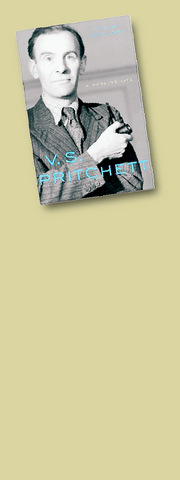For nearly all of his very long life and career, VS Pritchett, the novelist, short-story writer and critic, was a man in the middle. Like Charles Dickens and HG Wells before him, he came from the English lower middle class -- "my country," he once called it -- and found his best material there. In politics, he took a humane position somewhere to the right of the left and to the left of the right. In his personal life, he was a devoted but not very faithful husband. He was too famous to be a cult writer, but never popular enough to escape the constant drudgery of reviewing, travel writing and other miscellaneous literary journalism.
Drudgery, however, suited Victor Sawdon Pritchett, or VSP, for short. He thrived on it, as Jeremy Treglown makes clear in his concise, rather dutiful biography, appropriately subtitled A Working Life. Deadline and

financial pressures simply reinforced Sir Victor's ferocious work ethic and drew the best from his quicksilver sensibility.
"I get a curious masochistic and nonconformist pleasure out of excessive work and especially out of work of the wrong kind," he told his friend Gerald Brenan. "I get a cussed kick out of earning my living; and the artist in me is in perpetual harangue with the tradesman."
Passionately intuitive, with an extraordinary emotional and intellectual range, he gravitated naturally to the short story and literary essay, turning out one little masterpiece after another, seemingly without effort. In his early days as a literary journalist, he routinely turned in reviews dealing with a half-dozen or more books at a time. The novel, by contrast, daunted him, although he wrote five. Too slow. Too boring. "People say a bank clerk's life is monotonous," he once wrote, "but it is nothing to compare with a novelist's."
Pritchett's "working life" presents problems for the biographer. For decades at a time, not a lot happens. By the time Pritchett reached his 30s, he had settled into a hugely productive routine that he stuck to for the remaining 60 years of his life. (He died in 1997 at age 96.) As his enormous output suggests, he spent most of his time sitting down, writing. Even worse for Treglown, he told the story of his own life in two sparkling memoirs, A Cab at the Door and Midnight Oil.
That leaves Treglown with the mostly curatorial duty of arranging the novels, stories and essays in chronological order and annotating them with a few biographical details and snippets from contemporary reviews.
This approach quickly becomes tedious, especially when Treglown takes on a professorial tone in explicating the fictional work. Pritchett's last and best novel, Mr Beluncle, we are told, "maps a crucial phase of lower-middle-class English patriarchy." (The novel has just been reissued in paperback by Modern Library, which has also published Essential Stories, edited by Treglown.)
Treglown does make the most of his limited opportunities, however. He does an excellent job separating fact and myth in Pritchett's somewhat Dickensian account of his family life, dominated by his feckless, Micawberish father. The straits were not as dire, the family atmosphere not as turbulent, as Pritchett liked to think. He did leave school at 16 to work sorting skins on the London docks (an episode that provided material for his first novel, "Nothing Like Leather"), but lack of formal education, Treglown notes, may have been a blessing in disguise. For one thing, as Pritchett himself later admitted, it probably saved him from a career as a schoolteacher.
It may also account for the energy and the highly personal, impassioned tone of his literary criticism. "He often said that because he had not been to university, he had no preconceptions about a literary pecking order," Treglown writes, "and that because he was a practicing fiction writer, he approached other writers in the spirit of wanting to find out exactly what they were doing, and why."
His literary criticism made a powerful impact on writers as disparate as Susan Sontag and Gore Vidal, who may have summed up its genius best. "Pritchett," he wrote, "is rather like one of those amorphic sea-creatures who float from bright complicated shell to shell. Once at home within the shell, he is able to describe for us in precise detail the secrets of the shell's interior; and he is able to show us, from the maker's own angle, the world the maker saw." With a few minor changes, this passage could apply to Pritchett's uncanny power to create fictional characters, too.
Pritchett married twice, the first time disastrously. Treglown picks through the earlier marriage with great sensitivity, linking Pritchett's rejection of his early work to his unhappy marriage. Marriage No. 2, which lasted from 1936 until his death, was also a complex relationship. He met Dorothy Roberts, then 19, through his wife (the two women worked in the same agent's office in London), and fell for her at once. Pritchett's wife, for her part, soon found love and happiness in the arms of a much younger man.
Throughout, Pritchett kept to his work schedule. He was that oddity among artists, a happy man. The stories, the essays, the travel books poured out. He became a frequent speaker on radio and a popular television guest. He also had a long, profitable relationship with American magazines like The New York Review of Books and The New Yorker.

US President Donald Trump may have hoped for an impromptu talk with his old friend Kim Jong-un during a recent trip to Asia, but analysts say the increasingly emboldened North Korean despot had few good reasons to join the photo-op. Trump sent repeated overtures to Kim during his barnstorming tour of Asia, saying he was “100 percent” open to a meeting and even bucking decades of US policy by conceding that North Korea was “sort of a nuclear power.” But Pyongyang kept mum on the invitation, instead firing off missiles and sending its foreign minister to Russia and Belarus, with whom it

When Taiwan was battered by storms this summer, the only crumb of comfort I could take was knowing that some advice I’d drafted several weeks earlier had been correct. Regarding the Southern Cross-Island Highway (南橫公路), a spectacular high-elevation route connecting Taiwan’s southwest with the country’s southeast, I’d written: “The precarious existence of this road cannot be overstated; those hoping to drive or ride all the way across should have a backup plan.” As this article was going to press, the middle section of the highway, between Meishankou (梅山口) in Kaohsiung and Siangyang (向陽) in Taitung County, was still closed to outsiders

President William Lai (賴清德) has championed Taiwan as an “AI Island” — an artificial intelligence (AI) hub powering the global tech economy. But without major shifts in talent, funding and strategic direction, this vision risks becoming a static fortress: indispensable, yet immobile and vulnerable. It’s time to reframe Taiwan’s ambition. Time to move from a resource-rich AI island to an AI Armada. Why change metaphors? Because choosing the right metaphor shapes both understanding and strategy. The “AI Island” frames our national ambition as a static fortress that, while valuable, is still vulnerable and reactive. Shifting our metaphor to an “AI Armada”

The Chinese Communist Party (CCP) has a dystopian, radical and dangerous conception of itself. Few are aware of this very fundamental difference between how they view power and how the rest of the world does. Even those of us who have lived in China sometimes fall back into the trap of viewing it through the lens of the power relationships common throughout the rest of the world, instead of understanding the CCP as it conceives of itself. Broadly speaking, the concepts of the people, race, culture, civilization, nation, government and religion are separate, though often overlapping and intertwined. A government